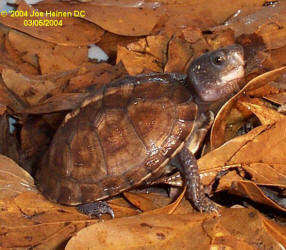General Care
For specific care check
www.aboxturtle.com
Box turtles need a set up which will simulate their
natural environment. Ideally an outdoor set up works best. They require
high humidity with a damp substrate and a good source of water for
swimming/soaking daily. If kept indoors provide the largest enclosure
you possibly can. A large 50+-gallon Rubbermaid type container works
well enough, but bigger is even better.
Contrary to what some might say, Box turtles do
like to bask in the sun as well as be able to hide in a dark moist area.
Providing a good basking lamp is important. Avoid any type of heating
pad or heat rocks. They have the potential to burn a turtle and turtleís
donít naturally get their heat from below them, but rather from the sun
above, so again, simulate natural conditions. The basking area should be
in the range of 90-95į, but the turtle must also have a
cool side to the enclosure to retreat to if it wants to. A good
microclimate is important. In addition to a basking light a good UVB
lamp is also a necessity if the turtle is kept indoors. A good
investment is a quality UVB/heat lamp, which not only provides good uvb
output and heat, but also only requires one fixture as opposed to two
when using separate lamps fur uvb and heat.
A Box turtleís diet should consist of live foods as
well as fruits and vegetables and good quality greens. They love
earthworms, slugs, snails, mealworms, superworms, crickets, pillbugs,
pinky mice, etc. You can also feed them shrimp, sardines or other fish.
The smellier the food it seems the more attracted they are to it. Most
will readily eat cantaloupe, strawberries, mango, papaya, banana,
blueberries, raspberries, kiwi, grapes, tomato and other such fruits.
The riper the fruit the more they seem to enjoy it. Sweet potato,
squash, green beans, green or red peppers. Some but not all Box turtles
will eat red leaf lettuce, dandelion and chicory along with other good
greens. To get a fussy Box turtle to eat their fruits, veggies and
greens they can be chopped into small bits and mixed into their favorite
foods like a mash.
Avoid any pelleted form of Box turtle food sold by
pet stores. Itís not a complete nutritional diet as claimed on the
container, but rather a catastrophe waiting to happen. Visit our rescue
page
http://www.turtlerescues.com/rescues.htm to see what providing only
pelleted food can do to a turtle. Granted, this turtle was given all the
wrong care, but a proper diet would have helped a great deal to keep it
from becoming so deformed.
Be sure to visit
www.aboxturtle.com for more specific information about each species
of Box turtle.
